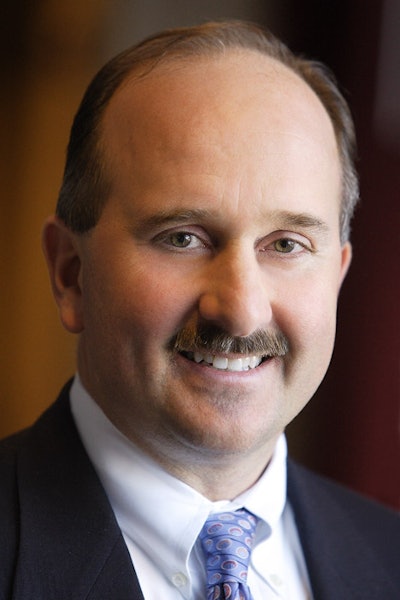
responses submitted by Allen Schaeffer, Executive Director, Diesel Technology Forum
Global Markets
How is the conversation about diesel changing around the world regarding diesel fuel and emissions restrictions?
The conversation is expanding beyond just beyond clean air to global greenhouse gas reductions, and also beyond just the engine and fuel to the broader system, whether that is freight operations around ports or construction sites. Efficiency and productivity never go out of style and manufacturers are bringing new connectivity and expanding automation potentials as well. Diesel being the gold standard for engines and equipment in heavy-duty applications, it is naturally the subject of many comparisons to new fuels, powertrains etc., and not all of these are apples to apples comparisons.
On the fuel side, recent moves by the International Maritime Organization (IMO) to require a switch to low-sulfur marine fuels in 2020 have created buzz about the impacts on the global oil market and future fuel pricing. As of 2018 about 70% of the world’s road diesel is ultra-low-sulfur diesel, according to the IEA (no more than 10-15 ppm). This fuel is the foundation for facilitating the introduction of cleaner generations of engines and equipment, enabling emissions reductions, and contributing to better air quality.
As you might expect the Volkswagen (VW) emissions cheating scandal has dominated discussions around passenger cars off and on for the last three years; overall it is declining in the United States, but we haven’t heard the last of it in Europe.
The market pull-through of newer technology is definitely a topic in the United States, with booming sales for new heavy-duty trucks, solid future orders and many machine segments showing positive trends. It’s a welcome sign that customers are replacing old equipment with new.
Politics & Government
Has the rumored lowering of emissions standards for cars and trucks in the U.S. been a welcomed idea?
Heavy-duty engine and vehicle manufacturers in the United States have been engaged in a public dialogue now with the U.S. Environmental Protection Agency (EPA) and the California Air Resources Board (CARB) for about a year. These discussions center on the potential for lower nitrogen oxide emissions from new heavy-duty on-highway engines starting at some point in the future.
The track record of heavy-duty truck and engine manufacturers working cooperatively with regulators to explore the technical and other aspects of taking emissions standards down even lower dates back to early memorandums of understanding with CARB and the EPA in the 1990s, so lots of positive history there regarding alignments and a single national standard. But every step is a different discussion and this one is different, especially with the political situation between the EPA and California.
I do think the challenge at the next stage for lowering diesel emissions is also different – the diesel engines being introduced in the market today are already very low emissions. Going down even lower challenges the scientific limits of detection on test equipment, sensors and the like. Rolled up into that are issues involving test procedures, on-board diagnostics, adequate head-space in the standards to allow for deterioration factors and other considerations. All of these things are just as, if not more important than the numerical standard.
I think there is also an opportunity for streamlining some of the testing and certification process to positively impact the cost, complexity and time for certification, so in that sense good for everyone.
How do the proposed diesel bans in major cities for automotive impact heavier duty diesel vehicles?
We don’t see any impact whatsoever. To be clear: the bans that have been proposed or enacted in a few small towns in Germany on a very limited basis are targeting passenger vehicles of a certain generation of technology (generally Euro IV). These are older vehicles that do not have the benefit of modern emissions controls like particulate filters and NOx control. There is a pretty clear delineation between the situation involving passenger vehicles and anything related to commercial vehicles. In some emissions testing that has been reported, some heavy-duty Euro VI trucks have actually reported lower real-world emissions than some newer passenger vehicles.
How is DTF involved in policy to positively affect the diesel market?
Our work is the day-to-day education of new and existing policymakers, influencers, decision-makers and the media. DTF does not lobby on policy issues. I do think a role we have is to try insert some reality on which technologies are working today, what new ones might have to offer if they are proven out, and why diesel remains the prime mover in so many economic sectors today. Popular media coverage tends to romanticize anything new or trendy, while taking what often feels like a biased, lesser and frequently negative view of existing and proven technologies.
As for the heavy-duty market, recent research shows that 36% of all commercial trucks Class 3-8 now use 2011 and newer generation diesel technology, achieving near-zero emissions. That sector experienced a 6% increase from 2016-2017, proving that truckers like what they see and continue to invest in the latest generation of new, more fuel-efficient diesel technology.
Other efforts on heavy-duty over the last year have been in the context of the VW Emissions Settlement, especially around states’ spending decisions for the $2.8 billion Environmental Mitigation Trust. We have been educating stakeholders and the public, filing comments and supporting technical info, and doing a lot of media work to spread the word on the cost-effectiveness of upgrades to large engines in the marine and rail sectors, and how these should be a prime choice for investing states’ VW dollars. The superior cost-effectiveness of a diesel replacement is substantial. Research we completed this year with the Environmental Defense Fund found that replacing one older marine engine with new diesel generates emissions benefits equivalent to replacing 74,000 cars for a year!
As for the diesel automotive market, there are 45 great diesel car truck or van choices today by a dozen manufacturers representing 10 brands. We are excited about the ‘diesel pickup truck wars’ about to get underway between Chevrolet, Ford and Ram, which are all offering full-size diesel options in their most popular model of pickup trucks. SUVs and larger vehicles really are a sweet spot for what diesel offers and new diesel introductions there just happen to be in the long-standing top selling products as well, where some greater fuel efficiency could have a big impact across a large purchase base. We have a range of tools and information available to convey this information to anyone interested.
Diesel vs. Electric
Do you think there will always be a place for diesel-powered equipment for heavy-duty applications? Why or why not?
Yes, without hesitation. The great diversity of demands for reliable and durable engine power in any place, condition or circumstance is not changing. I am reminded of recent images of excavators and track-type tractors creating barriers, clearing away debris and opening roads along the coast in hurricane-ravaged portions of the Carolinas, where electrical power was out for days. I saw high-ground-clearance National Guard vehicles rushing down to deliver aid and security. I heard of businesses relying on diesel generators during the power outages. The combination of features diesel offers – energy efficiency, power density, reliability, durability – are hard to beat. That’s why diesel is still number one today across 15 sectors of the global economy.
What would electric power sources have to achieve in order to replace the diesel engine for heavy-duty applications?
Just imagine the vast array of engines, machines, vehicles and equipment that perform work every day. At best, electrification is most likely to be a niche impact.
It’s a multi-dimensional analysis – the numbers of acquisition, owning and operating obviously have to make a compelling case. This is harder than it sounds, because so much influence for purchasing new technologies comes from one-time incentives, government or private inducements to acquire new technology or infrastructure. Those inducements won’t always be there, so longer-range questions looking 10 years out and beyond should be asked. For contractors or truckers, there is also the question of how a switch of technology would play with the rest of the business, since it is unlikely to switch entirely all at once.
As with any major decision, there is also the ‘gut feeling’ part, which is often the key part. Why are we doing this? Will new market entrant manufacturers, who are promising so much, still be around in 25 years to support my investments in their products and technologies? Do these new manufacturers have the level of nationwide service that we have become accustomed to? If I have a problem with 100 of their vehicles or equipment, are they going to stand behind it?
What do you think is the next step for emissions regulations after Tier 4 Final and Stage V?
Clearly there is a broader and deeper focus now on in-use emissions performance. Moving out of just laboratory certification testing, manufacturers want to reduce redundancy in testing and see opportunity in the next step of emissions regulations. There are also some big tradeoff issues relative to setting standards for each of the competing objectives of lower greenhouse gas emissions and reduced particulate and NOx emissions. Whatever any next step is, there will be an interest in a nationwide regulatory approach; that we can say with confidence.
Challenges & Opportunities
What excites you about the future of the heavy-duty vehicle market?
I’m excited by the new applications for diesel technology I see happening, and watching them coming to market. Many manufacturers have begun combining diesel engines with alternate powertrains, creating hybrid diesel-electric applications. We’ve seen this especially applied to technologies used around port operations. These hybrid machines combine the power and efficiency of the diesel engine with the possibilities of battery technology. In some applications, manufacturers are adding geo-locating technology too, so engines can automatically switch from battery-only operation dock-side at the port, to diesel-only operation when hauling power is needed on the road.
Where are the challenges you are either currently dealing with, or foresee down the road?
The biggest challenges down the road will be how and if all these exciting new technologies and innovations on engines and equipment make it into the market in significant numbers. For that to happen, you need the right kind of economy and the confidence in the user industries to make and sustain those investments.
There is also a tremendous opportunity to modernize and upgrade many older engines and equipment used in off-road and other key sectors. When we learn that an engine that was supposed to have a useful life of 15 or 20 years is still operating at 30+ years – it is a testament to the technology, but that user is missing out on the advantages of the new generation of technology: productivity, safety, efficiency, performance. Getting more newer technology to work benefits everyone.
Other challenges are bigger ones: politically motivated ideology fueling actions not based in fact or reality. Case in point: proposed bans on all internal combustion engines in the future. These kinds of statements I think will be detrimental and backfire politically and practically. Consumers of all types want and need choice. Plus, such decisions are shortsighted: there are investments being made in renewable fuels, usable in internal combustion engines, that demonstrate enormous benefits in reducing greenhouse gas emissions. Eliminating the internal combustion engine would negate these benefits, at enormous expense – not only the purchase of untested technology, but the costs of setting up new infrastructure and dismantling the old one. Tackling global warming requires many solutions, and next-generation internal combustion engine technologies, including diesel, will be part of that solution.



















